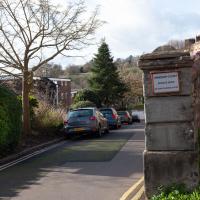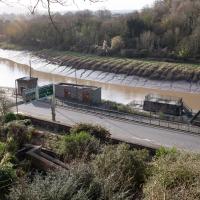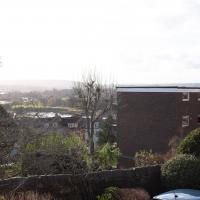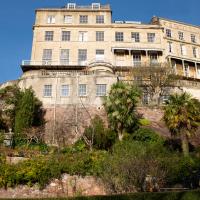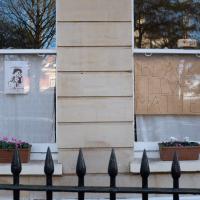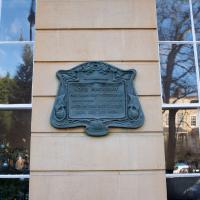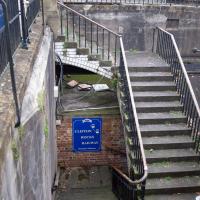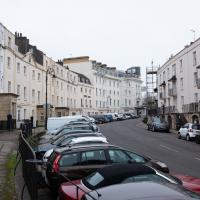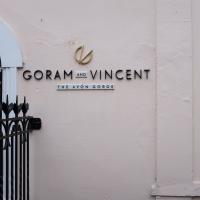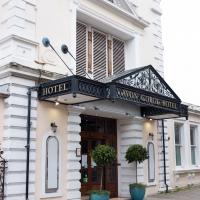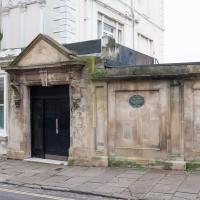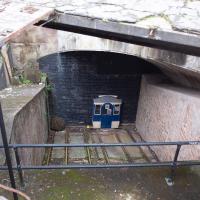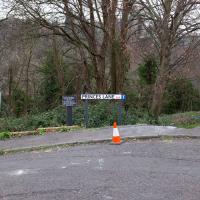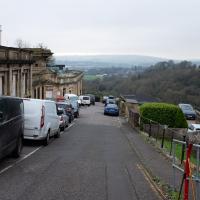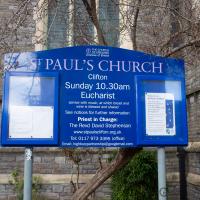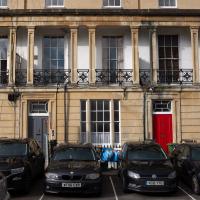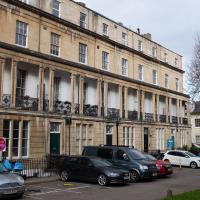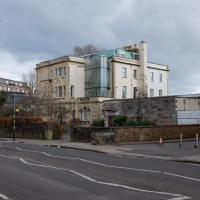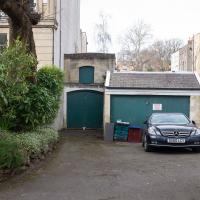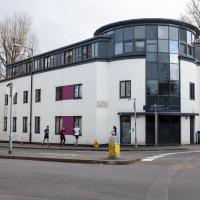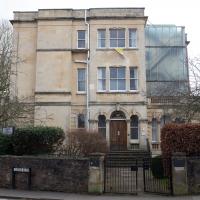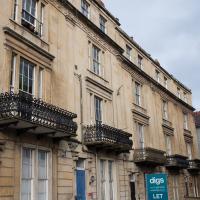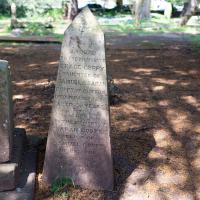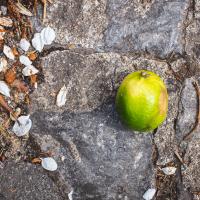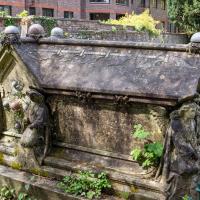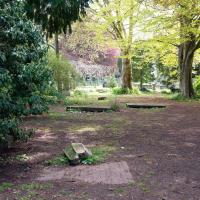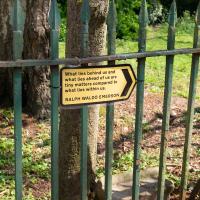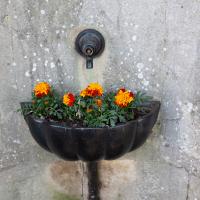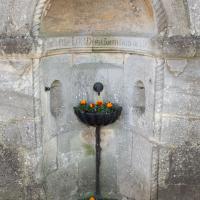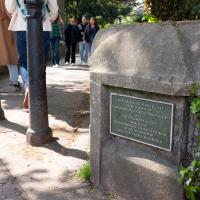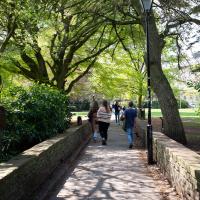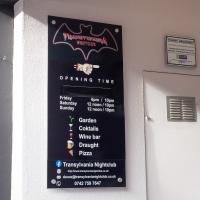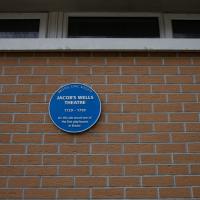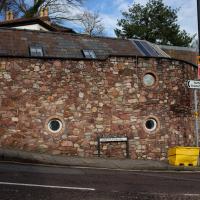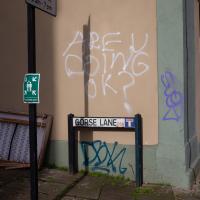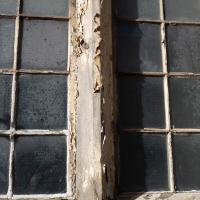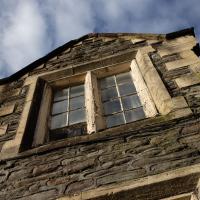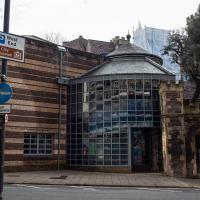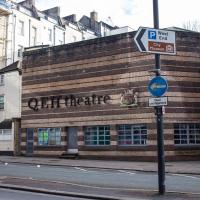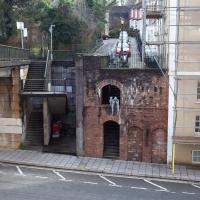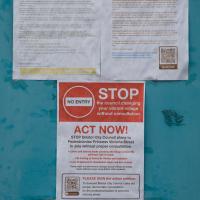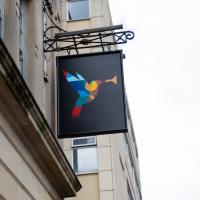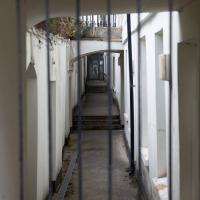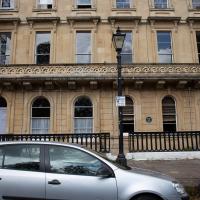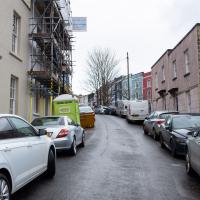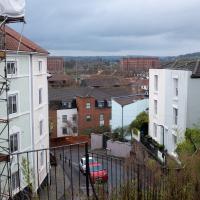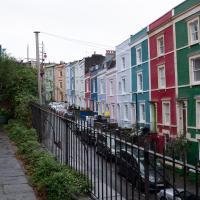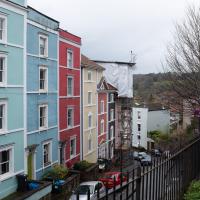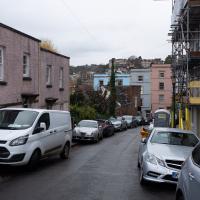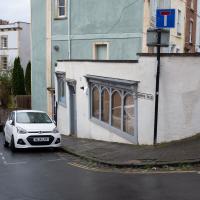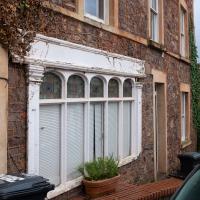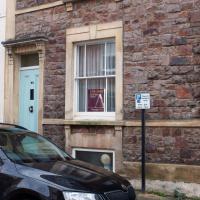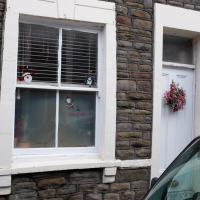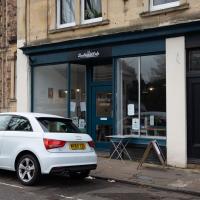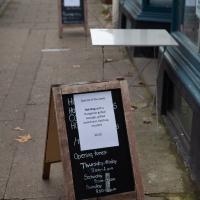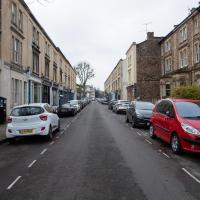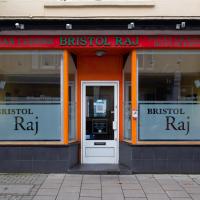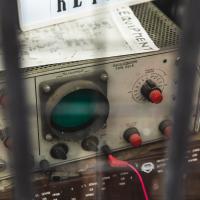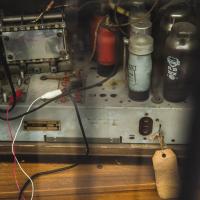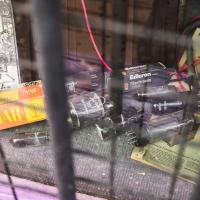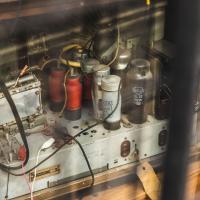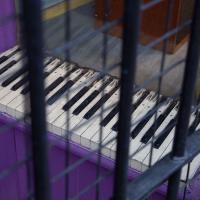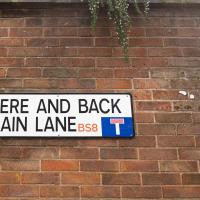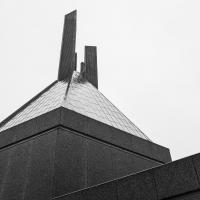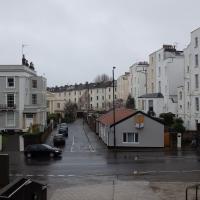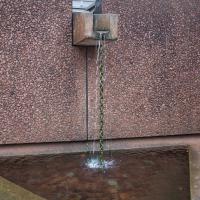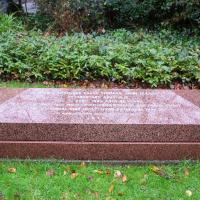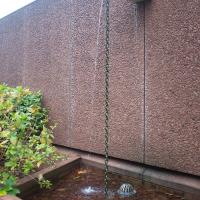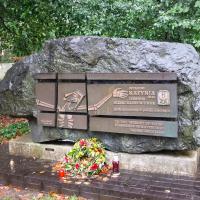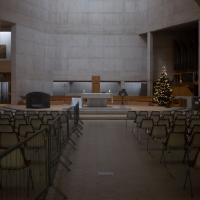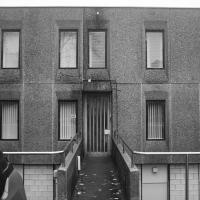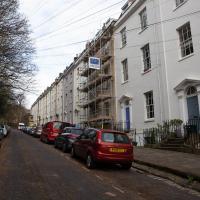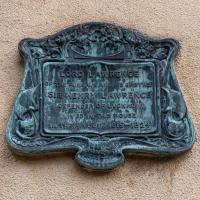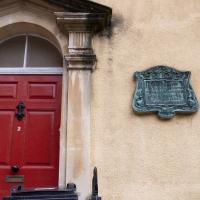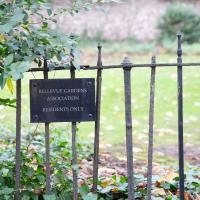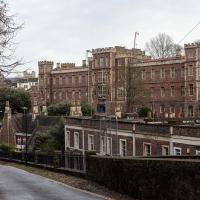Tagged: clifton
Strangers' Burial Ground
04 Dec 2020
I tried to find the Strangers' Burial Ground the last time was up in Clifton, but I'd not realised that Lower Clifton Hill continues further on after the turning with Constitution Hill. Sadly it was chained shut, but it still looks beautifully-maintained, perhaps by the same man referenced by this story from John Hodgson, which helped me find it. Apparently Thomas Beddoes is buried here.
Although, given the sign, perhaps I shouldn't have. But I didn't think they'd object terribly. I've actively interested in living here; a couple of flats have popped up on the market in recent times and the views are amazing.
Prince's Lane
06 Jan 2021
The International Grotto Directory website says:
Prince’s Lane might have been one of the original ancient tracks from Hotwells to Clifton, in the Avon Gorge. The site later formed part of Rownham Woods which comprised some thirteen acres. By the end of the 18th century and the early 19th century, the Society of Merchant Venturers granted to Samuel Powell a building lease, for The Colonnade (1786), St. Vincent’s Parade (1790), Prince’s Buildings (1796), and Rock House. Rock House is generally considered to be the oldest surviving building associated with the Hotwell (see Chapter 20). John Power conveyed part of the woods to William Watts for the construction of Windsor Terrace (1790-1808).
The above development of the Avon Gorge cleared Rownham Woods, and created a triangle of land on the north side of the gorge, that became enclosed as a result, by Mansion Houses, whose garden walls all entered on to Prince’s Lane. The Lane started at the bottom of the gorge, at the base rock of Windsor Terrace, and came out half way up Sion Hill. It is clearly shown as a public footpath, dotted with trees, in Ashmead’s map of 1828. Some of the gardens were quite steep in parts and therefore, had to be terraced, because of the gradient of the gorge.
I've passed Prince's Lane literally thousands of times in my life, every time I've walked past the Avon Gorge Hotel, which itself started (in 1898) as the Grand Clifton Spa and Hydropathic Institution and pumped water up from the Hot Well for its hydropathic treatments. I've never actually ventured down it until today, or at least nothing like as far down it as I did this afternoon—I may have poked my head around the back of the hotel to see the original pump rooms at some point in the past.
This was a great wander, though it does very much feel like a private road, and frankly I may have been pushing my luck a bit by winding my way between the astoundingly big back gardens of the houses of some presumably very wealthy Cliftonites, but I felt vaguely justified in exploring the history of one of the oldest footpaths in my part of Bristol...
Or the first sight of them in the distance, anyway. The terrace on the left is Prince's Buildings; we'll be walking being their gardens in a bit...
This building is 1894, but commemorates the original Hot Well House down in actual Hotwells, built in 1694.
The nice folk who look after the Clifton Rocks Railway have an example of what one of the carriages would look like at the top, though the tunnel here has been bricked up for a long, long time. If you get the chance to visit on one of their open days, it's pretty fascinating.
One of the oldest paths from Clifton to Hotwells, though there's sadly no way through to the Hotwell Road from about the halfway point now. Apparently it was rather charming in its day, and I could sense some of that history as soon as I got away from modern traffic and street furniture and further into the woodland.
I always enjoy peeping down Prince's Lane on the way past and enjoyin the view of distant hills.
Arlington Villas and WH Smith Destruction
10 Feb 2021
I actually dashed up to Clifton to take a look at Arlington Villas, just around the back of St Paul's Road, one of those slightly odd little enclaves of overlooked housing that you know is there, but you never have a reason to visit or travel down. As it turned out, interesting though the (public) garden is, I actually took far more pictures of the now-completely-demolished site bounded by King's Road, Boyce's Avenue and Clifton Down Road where WH Smith and other places used to stand.
It's interesting to imagine how nice this little area would be if turned into a permanent public square, but of course the developers already have their planning permission to build it right back up again.
Are these balconies? Or is it technically a loggia? Oh, according to the listing, it's:
Recessed first-floors behind a stone colonnade with paired, panelled columns to an entablature.
I'll never get the hang of what's what in architecture.
There's a strip of hotels on St Paul's Road; they make the most of the available space by converting as much basement as possible to rooms.
Leftovers with Lisa
01 May 2021
I didn't get to all the little leftover streets around the northeastern part of my area in today's wander, but I definitely knocked a few off the list, plus Lisa and I enjoyed the walk, and didn't get rained on too badly. We spotted the hotting-up of Wisteria season, checked out Birdcage Walk (both old and new), ventured onto the wrong side of the tracks1 and generally enjoyed the architecture.
1 Well, technically we probably shouldn't have been on the grounds of those retirement flats, but nobody started chasing us around the garden with a Zimmer frame
She was a gifted and prolific inventor, by all accounts, though apparently the news stories from a year or two back about her having had significant design input into the Clifton Suspension Bridge were due to an erroneous entry in the Oxford Dictionary of National Biography, oddly.
This seemed to augur well, given that we were heading for Lime Walk. This is, oddly, not the first piece of random fruit I've come across unexpectedly on my wanders.
I have The Portable Emerson on my "incoming" bookshelf, I think, but I'm not getting through them very quickly at the moment.
It's nice to see one of Bristol's defunct fountains being put to some kind of purpose.
This basement club will be more student flats soon, by the looks of it. Though I actually took this photo to remind myself of a possible plot point for a story I'm writing...
I'm now a member of the Cliftonwood and Hotwells Improvement Society. I kept on coming across things they'd done that I approved of, so it seemed like a good idea.
There's some fascinating stuff on Victoria Square here, including a lot of jumping-off points for deeper research. The description of the bombings during the war is amazing.
This is the path that used to be known as Birdcage Walk—up until the war it was lined with tall railings—but most people now use that name for the corridor made by the pleached lime trees in St Andrew's Churchyard, just a stone's throw away. I suppose that's the one that most resembles a bird cage today. Here's a Vaughan Collection photo of what it looked like before the war.
Adjacent on the left (Merchant's Road) side would have been the church of St James the Apostle, which survived the war but was demolished for flats in the seventies.
In Between
06 Feb 2021
A lovely walk in the early spring sunshine with my friend Lisa. We headed directly for Jacobs Wells Road, to start off around the scene of one of our earlier walks, but this time took in Jacobs Wells from QEH upward, stopping to snap some photos of a Bear With Me, some interesting areas between Park Street and Brandon Hill including a peculiarly quiet enclave with a ruined old build I'd never found before, then crossed the Centre to grab take-away pies from Pieminister (I had the Heidi Pie) and head back to my place down the harbourside.
Unlike the other day, there at least wasn't water flooding out of the well house today.
Green Squares and Secret Gardens
31 Jul 2021
At the end of July I went to have a look around some of the private gardens opened up by the annual Green Squares and Secret Gardens event. Sadly it was compressed into a single day this year, for various Covid-related reasons, it seems, so I didn't get to poke around too many places. I went to:
- A talk by the oldest resident of Victoria Square
- The St Vincent's Rocks Hotel garden
- The Paragon garden
- Cornwallis Crescent gardens, both east and west
- The Polygon garden
And snapped a few things in between, too. It was a lovely day—a bit too hot, if anything—and it was interesting to get into a few places I'd only ever seen from the outside, especially The Paragon and Cornwallis gardens, which are the least visible to passing strangers of all of them.
This is how the other half live—making sure that the Suspension Bridge is still there without having to leave one's boules court.
It's a little tamer now than it was back when anti-residents' parking zone protesters drove a tank through the city to deliver their petition. This one's about an experiment to pedestrianise Princess Victoria Street.
Won't make any difference to me one way or the other, really; I just walk up to Clifton Village for my shopping. Or, quite often, in completely the other direction, to North Street in Bedminster. I like both areas for shopping, and it's good to live close enough to either to get there on foot.
Kicked off my Clifton "secret gardens" visit by attending a talk by Victoria Square's "oldest resident", who is 95 and has lived there all his life. He did mention his family name in passing, but I've got a memory like a sieve, and his name's not on the event details. Ah well.
He really brought the square to life, with memories of the children playing in the square, making their way between the two halves using the tunnel—which I learned also had enough room to store the gardener's equipment, so must have been bigger than I thought!—and with the oldest child having a garden key hanging around their neck on a bit of string, ready to use when each family used a distinctive sound—anything from a whistle to a cowbell—to call the kids back home. He also touched on delivery men, including horsedrawn milk carts that would fill maids' jusgs from their churns, and the Walls ice cream boy who would visit houses who had hung the distinctive "W" sign in their windows on a Sunday, and gave many other amazing details. I really wish I'd recorded the event.
Among other new tidbits I can recall:
- Number 4 was blown to smithereens during WWII, hit so badly by a German bomb that bodies were blown into Mortimer Road. Grim.
- The "pinch point" made by the railings below the Arch House were motivated by a battle between the residents, and the Council and Merchant Venturers (who basically built/owned the Square, hence the adjacent Merchants Road) over a road that was planned to run diagonally through the square (as actually happened with Queen Square). The pinch point was constructed to preserve the maximum width of the existing right of way through the corner, making it too narrow for cars.
- The Victora Square Hotel used to be the vicarage for St Andrew's Church. Our Oldest Resident attended Sunday School there.
- The old [Church/Church Hall](htt
The Victoria Square event was at 11am, and I didn't have a lot of energy, so hanging around until 2pm for the Richmond Terrace Garden to open would've been too much for me. Maybe next year! The event might be back up to the whole weekend by then, rather than being squeezed into a single day.
This section of Victoria Square, the second side to be built (Lansdown Road is the oldest—Regency—bit) is called Royal Promenade, and it built to resemble a palace. William Batemen Reed built it, then went on to build the Queens Hotel opposite the Victoria Rooms, which every Bristolian I know would more likely recognise by the description "the old Habitat at the top of Park Street" :D
Apparently if the Royal Promenade were symmetrical, the windows of 7 and 8 would be the same size. As it is, 8 is clearly very slightly grander.
Nobody's quite sure why the Royal coat of arms appears here. Nobody royal appears to have given permission for it, and Victoria, as far as anyone can work out, never stayed here.
The weather appears to have been kinder to the unicorn than the lion.
More Cliftonwood
05 Dec 2020
Back to Cliftonwood for a wander that included some of the belle views of Bellevue Crescent and other bits of the easternmost part. Highlights included watching someone bump-starting an elderly Nissan Micra in the narrow confines of Bellevue Crescent.
A "bright and airy self contained single storey Freehold studio / workshop (277 Sq Ft)". The floorplan shows that it's basically just a single room with tiny room with a loo and a sink inset, and nothing else. I suppose an enterprising hairdresser or nail technician might be able to make something of it.
Alma Vale
06 Dec 2020
I wasn't really feeling it when I set out today, on my first car-assisted wander. By the time I'd parked on Alma Vale Road in Clifton it was just starting to rain and I picked my way about in quite a desultory way. It felt strange, as I was very familiar with the area because I'd walked through it hundreds of times when I worked at the top of Whiteladies Road, and used to walk up the hill from Hotwells and through Clifton to get there, and back again, every day.
Then a complete coincidence seemed to make the change I'd been hoping for. I was standing taking a photo of Christ in the front garden of All Saints church when a couple of people walked out of the front door. I got talking with a lady I took to be part of the ministerial team, who invited me to come in and look around—something I'd always wanted to do on the morning commute. (I think we connected a bit when I recognised the name John Piper, who did the amazing windows—I learned about him while I was at Warwick, through his connections to Coventry Cathedral.
I left with much more of a spring in my step, wandered around the area a bit more, finally working out that the tennis courts I used to pass every morning are those of Clifton Lawn Tennis Club, and finally grabbing an excellent Hungarian sausage hot dog from the Budapest Cafe. I feel a lot better now than I did before I went out.
Rainy Clifton
13 Dec 2020
A long walk around Cliftonwood and Clifton with my friend Lisa, taking in some of the 12 Days of Christmas display at Queens Parade, picking up a take-away coffee from Pinkmans of Park Street, and poking our heads up against the glass of SS Peter and Paul Catholic Cathedral.
One of the best street names in Bristol. The street itself isn't up to much, mind.
This seems to be the alternative to drainpipes at the Cathedral. It's not simply a 1970s fountain, as I first thought...
As ususal with religious stuff, I've just looked up what a protonotary is and am really none the wiser.
"The Katyn massacre was a series of mass executions of nearly 22,000 Polish military officers and intelligentsia carried out by the Soviet Union, specifically the NKVD ("People's Commissariat for Internal Affairs", the Soviet secret police) in April and May 1940. Though the killings also occurred in the Kalinin and Kharkiv prisons and elsewhere, the massacre is named after the Katyn Forest, where some of the mass graves were first discovered." — Wikipedia
Considering I was shooting thorugh a smoked-glass window I don't think I did too badly. One day, with a bit less pandemic around, I'll take the tour.
We presumed this was the presbytery, and having checked the plans, we were right. Entered via a bridge.
Cliftonwood and Clifton Village Lunchtime Stroll
14 Dec 2020
The lunchtime walk has been feeling a bit of a chore lately, especially as I only have an hour and have to keep a mental watch out for my "bingo" point or risk being late back. Today I went for a deliberately brief local walk and got home in time to have lunch on my sofa rather than while I was back at work.
It's interesting filling in the gaps in my Clifton Village knowledge, especially starting to "see" the bits I can't see, the negative spaces. The size of both Fosseway Court and the Bishop's House gardens (check out the latter on Google Maps for an idea) are both something I've noticed by just getting to know the areas around them. I may also have to walk into the driveway of the very well-hidden Nuffield hospital to get an idea of how big it is.
None of those are anything compared to the trick of hiding the gargantuan public school that is Queen Elizabeth's Hospital so well that I keep on forgetting it's there, until a glimpse of it from somewhere like Lower Clifton Hill reminds me about it, of course...
I'd only heard of the Siege of Lucknow through cryptic crosswords. Don't @ me, I'm not a historian.
Queen Elizabeth's Hospital is not, of course, a hospital. That would be too simple. Founded (like Christ's Hospital) in the 16th century—1586 to be precise—it was and remains an independent school.
I'm always surprised how easy it is not to notice this giant grand building, set back and screened off by a tall wall along most of its border along Jacobs Wells Road, and backing onto the park at Brandon Hill.

